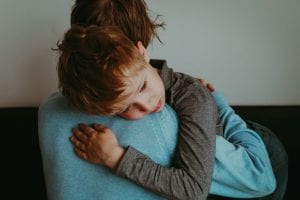Hurts can hurt again. As a grandparent raising grandchildren, you live with the consequences of childhood trauma even in the best of times. Your grandchildren have endured a lot. You may have experienced trauma yourself. Now you must cope this catastrophe. What can you do to blunt immediate trauma and reduce the risks of re-traumatization in your children?

Traumatic stress in the past an affect daily life.
Childhood Trauma: what is it?
From a psychological perspective, trauma occurs when a child experiences an intense event that threatens or causes harm to her or his emotional and physical well-being. Witnessing or being the victim of violence, serious injury, or physical or sexual abuse can be traumatic. Trauma can be the result of exposure to a natural disaster such the coronavirus outbreak. Sadly, about one of every four children will experience a traumatic event before the age of 16.
Common responses to trauma
Children react in both physiological and psychological ways. Their heart rate may increase, and they may begin to sweat, to feel agitated and hyperalert, to feel “butterflies” in their stomach, and to become emotionally upset. These reactions are distressing, but in fact they’re normal — they’re our bodies’ way of protecting us and preparing us to confront danger.
However, some children who have experienced a traumatic event will have longer lasting reactions that can interfere with their physical and emotional health. Children who suffer from child traumatic stress have been exposed to one or more traumas over the course of their lives. They may develop reactions that persist and affect their daily lives after the traumatic events have ended. Traumatic reactions can include a variety of responses, including intense and ongoing emotional upset, depressive symptoms, anxiety, behavioral changes, difficulties with attention, nightmares, physical symptoms such as difficulty sleeping and eating, and aches and pains, among others. When a child is experiencing child traumatic stress, they interfere with the child’s daily life and ability to function and interact with others. Children who suffer from traumatic stress often have these types of symptoms when reminded in some way of earlier traumatic events.
Re-trauma responses may differ
Responses to new trauma in an individual child are intertwined with the child’s mental and emotional strengths and weaknesses and what kind of support he or she has at home and elsewhere. Two children who encounter the same situation, may respond differently. Children are unique individuals, and adults shouldn’t make sweeping assumptions about whether they will or will not experience ongoing troubles following a traumatic event.
Importance of safe, stable environment
Children are not born with resiliency but it can develop over time through the strong and stable relationships with the important adults in their family and community. When important adults—you!—are perceived as unpredictable or threatening, trauma responses can be triggered. These triggers can include confrontations, family fighting, substance abuse in adults, and the use of discipline methods that increase isolation. (For practical ideas on de-escalating conflict, see our series of videos on this website.)
The National Child Traumatic Stress Network offers this guidance for how you can help your family cope with the coronavirus disease.
Preschool
Reactions caused by trauma
- Fear of being alone, bad dreams
- Speech difficulties
- Loss of bladder/bowel control, constipation, bed-wetting
- Change in appetite
- Increased temper tantrums, whining, or clinging behaviors
How to respond compassionately
- Patience and tolerance
- Provide reassurance (verbal and physical)
- Encourage expression through play, reenactment, story-telling
- Allow short-term changes in sleep arrangements
- Plan calming, comforting activities before bedtime
- Maintain regular family routines
- Avoid media exposure
School-Age (ages 6-12)
Reactions caused by trauma
- Irritability, whining, aggressive behavior
- Clinging, nightmares
- Sleep/appetite disturbance
- Physical symptoms (headaches, stomachaches)
- Withdrawal from peers, loss of interest
- Competition for adults’ attention
- Forgetfulness about chore
How to respond compassionately
- Patience, tolerance and reassurance
- Play sessions and staying in touch with friends through telephone and internet
- Engage in educational activities (workbooks, educational games)
- Set gentle but firm limits
- Discuss the current outbreak and encourage questions, include what is being done in the family and community
- Encourage expression through play and conversation
- Limit media exposure
- Address any stigma or discrimination occurring and clarify information
Adolescent (ages 13-18)
Reactions caused by trauma
- Physical symptoms (headaches, rashes, etc.)
- Sleep/appetite disturbance
- Agitation or decrease in energy, apathy
- Ignoring health promoting behaviors
- Isolating from peers and loved ones
- Concerns about stigma and injustices
How to respond compassionately
- Patience, tolerance, and reassurance
- Encourage continuation of routines
- Encourage discussion of outbreak experience with peers, family (but do not force)
- Stay in touch with friends through telephone, internet, video games
- Participate in family routines, including chores
- Planning strategies to enhance health promoting behaviors
- Limit media exposure
- Discuss and address stigma, prejudice and potential injustices occurring during the pandemic.

Recent Comments